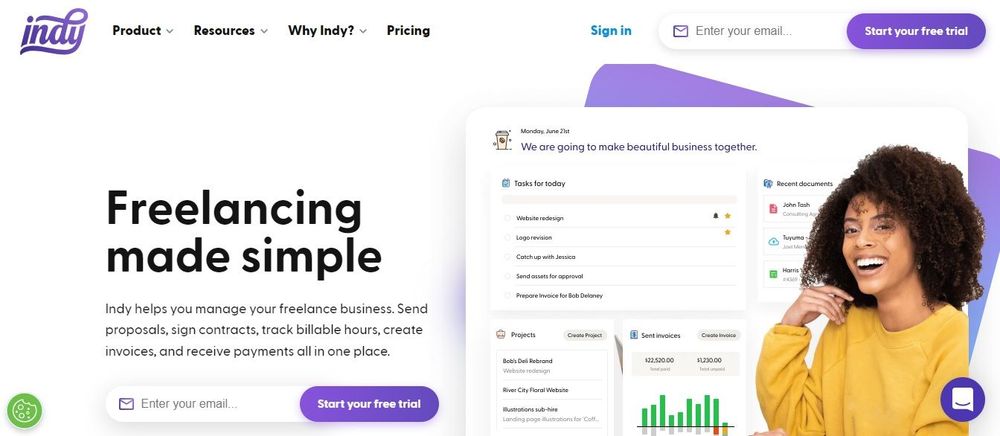Understanding your audience and designing your content strategy around it is probably one of the most important things you can do to help your project become a success. After all, if you know who's reading or watching your content, you can design it to be even more engaging and effective.
In this lesson, we will go through everything you need to know about how you can find your target audience and focus your marketing efforts on it more efficiently. We will also include a few tips on how to conduct market research and use tools like Google Analytics to gain valuable insights into your customer base.
What is a target audience, and why does it matter?
As usual, let's start with a definition. What exactly is a target audience, and why is it essential to keep it in mind as a content creator? In short, a target audience is a particular group of people you create content for (or at which you can aim advertising campaigns, books, movies, and more). This group will have specific characteristics, such as personality types and demographics, and, ideally, be interested in your content.
As a content creator, it's vital to know who your target audience is and what they expect or want from you—so you can offer it to them and grow your business. This is why it's essential not just to find who is in this group but also what their preferences are—their goals, their pain points, whether they are looking at other brands, etc. For example, what channels do they use more frequently? And how do they search for content?
When competing online, everyone is trying to make sure their products and their brand are easily discoverable—and that they are targeting the correct audience. This understanding should sit at the center of any marketing campaign, right between your promotional tactics and your go-to-market approach.
Defining a good strategy
When you define your target audience, you can then decide which keywords are most likely to lead them to your website. With this information in hand, you can develop a strategy to ensure your pages appear on their searches. Just remember, though: SEO is about marketing to people, not to search engines!
Let's go through a few steps for coming up with a good strategy. We'll focus on three main components: Creating and using personas, assigning them user journeys, and mapping your content.

Using personas to understand your target audiences
A persona is a semi-fictional character that represents a person or user type and is a rather popular marketing and design tool. Why semi-fictional? Well, these profiles, created to help you understand your target audience, are usually given a name, a face, some goals, and a few personal characteristics. This is so you can put yourself in your audience's shoes and try to see things from their point of view.
Personas are typically based on a combination of research and gut instinct. Research can take many shapes; for example, you can run surveys and use interviews to gather data from your existing customers or ask team members to collaborate in creating these fictitious archetypes. It's always a good idea to include obstacles and goals in your personas. What problems do these people have, and how can your organization or company resolve them? What are their goals, and can you fulfill them?
In this section, we're focusing mostly on target audience personas—not buyer personas. This is an important distinction as the second refers more to customers (and uses quantitative and qualitative data to build). Many experts who are more focused on content SEO believe personas give an unnecessary level of detail that's not required to promote content. However, they are a helpful tool that can be used for many different scenarios—so we believe they are worth considering.
Visualizing user journeys
Once you have some personas drawn up, it's time to create a user journey for each of them. This method aims to envision a person's experience from the moment they discover your content to the point where they make a purchase or take some action, such as subscribing to a newsletter or clicking on a button. Basically, everything from the first point of contact.
It's helpful to think of your user journey in terms of touch points. How and when did your persona come in contact with your content? Typically, there will be many touch points; for example, someone might land on a website through organic search results, a campaign, or social media marketing—just to name a few.
The user journey will be different for all your personas or target users, but it will always have a few phases that are relatively common. These are:
- Awareness phase: The user has a problem (he or she needs more information, wants to compare products, etc.) and starts looking for solutions to it. This is the phase when a person typically discovers your content, products, or service.
- Consideration phase: The user takes an interest in what you're showing them and evaluates different solutions to try and determine which one is best for them.
- Decision phase: The user picks a company or person that can help them solve their problem (or buys a product from you).
There are a few more stages (some customer journeys include at least half a dozen), but these three are the most common ones. Some of the activities included in them are SEO, social media and email marketing, special offers, reviews, YouTube videos, product demos, payment options, CRMs, after-sales services, and loyalty programs.

Mapping your content
Once you have identified and designed your personas and you are familiar with their user journeys, it's time to start working on your content. What is your target audience specifically looking for, and how can you give it to them?
The best way to answer these questions is to use something called content mapping, which is a method that can help you get an excellent overview of your strategy. Mapping is basically planning how you can address your content so it can address your users' needs at each step in their journey.
To create a good content map, you can do the following:
- Define your purpose and value: There are two essential pillars to a content marketing strategy: A business purpose (what are you trying to achieve, business-wise?) and a marketing mission statement (what value can you provide your target audience using your content?)
- Segment your target audience: Understanding your target audience is vital to content mapping, so you should try to collect as much data from your users and customers as you can. Then, segment it into sections. For example, what is making these users come to your site? Do they have a favorite product? What goals does it fulfill? You can also segment your audience using demographic data (such as gender and age), location, habits, behavioral patterns, and more.
- Write your brand story: Your brand story explains why you are creating content and how you intend to help others. In short, it's the value your pages or products are capable of providing. Who's the hero of your story? And what's the positive change you're selling? Remember, your brand is expressed through your content!
- Design your marketing funnels: You can encourage users to move through a funnel of tasks. A funnel strategy includes stages for awareness, consideration, and decision (what we saw in the user journey). You can map out your strategy for different content types using these three stages.
- Pick some topic ideas: Most marketers will decide what content they should create based on keywords (resulting from industry research, target audience research, and in-house knowledge). It's best if you start with broader themes and then develop clusters to go deeper. In time, you can add more keywords to these clusters.
Identifying target audiences
One important thing to remember is that a target audience is something quite specific. You shouldn't use umbrella terms and instead focus on a more refined target that takes into consideration demographics and personality traits.
With a well-defined target audience, you can be sure you'll be able to get your message across to the users that truly matter. But how exactly do you discover these groups, and what can you do once you have defined them?

How do you discover your target audience?
An excellent way to start is by looking at your existing audience and seeing what they have in common. For instance, you can inspect the following characteristics of your existing or potential audience:
- Geographic location: Are most of your audience located in a single place or time zone? If so, your strategy should take this into consideration so you can focus your efforts when you know there'll be more people around.
- Age and/or life stage: You don't need to pick a number for your audience's age; you can use a range. For example, 18 to 30 years old. The stage of life they are in can also come in handy. For instance, are they single, parents, retired, or building a career?
- Language: Does the group have a single primary language or more?
- Needs and challenges: What barriers does your audience have? And can you address other pain points?
- Personality: Are there any common elements among the people that follow you? For instance, do they share some hobbies? Do they engage with your competitors or other brands?
Now, how do you go about finding this information? As we mentioned, the easiest way is to look at your existing customer base, but if your content business is new, you might not have this yet. In this case, it can be a better idea to use analytic tools that can look into your different platforms or plan your strategy based on potential groups you can reach.
Let's see a few different options for identifying audiences in a little more detail, shall we?
Using analytics to identify your target audience
A lot of the information we mentioned above can be unearthed using analytic tools like Google Analytics. In fact, there's a whole section within the platform called "Audience." In it, you will be able to see the number of visitors you had for a specific period of time and analyze your visitors' demographics.
Google Analytics also includes your audience interests, or the sorts of things your visitors are interested in based on their online behavior and previous searches. For example, if you are a real estate company, you might see that your audience also looks for hotel accommodations and outdoor activities—as there are what's considered affinity categories.
There's a lot you can do within this platform to get valuable insights into your audience. All sections are labeled clearly, so it's quite easy to navigate through them. Plus, the Google Analytics dashboard has some handy graphics that make things even easier to interpret!
Checking social media analytics and insights
If you don't have a website yet, you can also use your social media platforms to gain some knowledge about how people are engaging with your channels. Every tool is different, and not all give you access to analytics, but a few do. And you can always look at the likes and shares and use this data to gauge how your content is doing.
Facebook has a tool called Insights, which is free and allows you to explore critical information about your audience. You can also use this feature to plan your strategy, as it includes data like demographics, lifestyle, purchases, and interests.
Social media analytics can tell you how people are interacting with your content—and give you some ideas on what's working and what's not. So, you can then adjust your posts to what your audience finds more interesting and engaging.

Using SERPs
SERPs is short for Search Engine Results Page, or what you see every time you submit a query to, for example, Google. If you're unsure whether you're targeting the right audience, you can use these searches to inspect the different rankings and determine a group of people's search intent.
All you need to do is write down words that are related to your main one and pay attention to any common themes you might notice. For example, the type of services being promoted and the tone of voice. These two alone can tell you a lot about the right audiences for a particular keyword.
What if you don't have any sort of audience yet?
Coming up with a target audience for an industry you're not familiar with can feel a little daunting, but there are ways to do this, too. All you need to do is put your ear to the ground and see what people are talking about.
Something you can do is monitor hashtags that interest you and see who's using them and how content gets structured around them. What are the most common keywords, and how does the competition take advantage of them? Are there any segments they are not considering yet?
If you're unsure where to get started, you can try a tool like BuzzSumo, which helps you explore social engagement data from thousands of sources. All you need to do is enter a keyword, and you'll be able to see all related content from influencers, journalists, and websites. Another excellent tool you can use to analyze the market is Semrush. With it, you can see how your content is positioned compared to your competitors or look into any existing website and get ideas for keywords and potential target audiences (pay special attention to the "Market Audience" report).
The difference between target audience and target market
Before we continue exploring how you can find a target audience and tailor your content to it, we should briefly discuss the difference between two fundamental terms: Target audiences and target markets.
As we mentioned, the target audience refers to a group to which you can serve advertisements or content. The target market, on the other hand, is a set of consumers to which a company plans to sell products to or reach using a marketing campaign. In short, a target audience is a more specific sub-segment within the target market.
Say, for example, that your target market is cyclists—and there's a challenge coming up soon. Your target audience for a specific content campaign could be, for instance, cyclists that are participating in that challenge, as opposed to anyone who uses their bike for sport.
In some cases, you can use target audience to mean target market. However, the opposite is not true; target market doesn't always mean target audience.

The difference between decision makers and supporters
There's one more difference we need to explore, and that's the one between two different roles your target audience can have.
On the one hand, you will have decision-makers. These are the people that will ultimately make the decision surrounding a purchase. They might play other roles, too, but they will decide whether your product or service is worth it. Many brands have, in the past, made the mistake of trying to appeal to younger generations—when it was actually their moms buying the items!
On the other side are the supporters. Supporters might not have enough power to make a decision, but they can influence those that do heavily. To continue with our last example, a child might not be able to buy a toy, but they can tell their parents which toy they want!
When you develop a strategy to target an audience, it's essential to remember both these roles so you can try to speak to both.
Find your target audience in 3 easy steps
Let's go through the main steps you can take to find your target audience as a content creator and know when it's the right time to reach out to them.
- Analyze your customers and conduct market research: As we said, one of the best ways to determine your target audience is to look at who's already using your products or reading your content. Of course, looking at some industry marketing research can go a long way as well—especially if you can look for trends and opportunities you can fill.
- Investigate your competitors: You can learn so much by looking at what the competition is doing! And so much more by noticing what they are missing!
- Create personas and revise them frequently: Personas can help drill down the specific segments you can target, which can be an issue if your content attracts a wide swath of people. Develop a few of these fictitious characters, and don't forget to update them as you interact with your visitors and gather more data.
Once you've done your homework and know who your target audience is, you can start thinking about where and when it's the best time to reach out to them.
Target audiences and SEO
The power of understanding who's looking at your content will give you the ability to also drive the best traffic to your site or project because, once you know who they are, you can put a good SEO strategy into place.
With a target audience at hand, you will be able to identify the search terms people are using (and that you should optimize for) and create content that is relevant and interesting to a specific group of people—those that have a higher chance of becoming your next customer or client!
Conclusion
In today's world of content creation, you need to understand who your target audience is so you can put in place a strategy that converts and drives growth. Your traffic needs to come from the right people, or your content won’t be as effective as it can be. In short: Targeting your audience has the potential to increase your relevance, which in turn can put your business right in front of the right people.

There's little doubt that keywords play a huge role in effective content creation. Understanding and targeting the correct audience, though, can maximize the chances of your business becoming a success. When you're mapping out your content plans for the weeks and months ahead, it’s important to have a strong system to organize your content schedule. Sign up for Indy today, the Tasks and Calendar tools can help you every step of the way.



